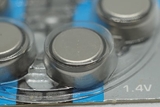
Button Batteries Are Poisonous
Button batteries can be found everywhere in the home: inside toys, remote controls, watches, lights and other devices. The small, coin-shaped discs, also known as lithium batteries, represent a growing risk of injury, and in some cases, death, for small children.
When swallowed, these batteries can get stuck in a child’s throat. Once inside, a child’s saliva interacts with the battery’s charge for a chemical reaction that burns tissue, may damage vocal cords and more. Within hours, the battery may burn a hole through the airway, causing catastrophic damage or fatal internal bleeding.
“Parents have to be very vigilant about family devices. Severe injuries often occur in under two hours,” says Ian N. Jacobs, MD, Director of the Center for Pediatric Airway Disorders and a pediatric otolaryngologist at Children’s Hospital of Philadelphia (CHOP). “The time between ingestion and removal is a critical time to act in order to reduce esophageal injury.”
Children younger than 6 are most at risk of swallowing a button battery. As infants and toddlers explore the world, often with their mouths, they find small shiny batteries dangerously appealing, says Dr. Jacobs, who also co-founded the National Button Battery Task Force at the American Academy of Pediatrics (AAP). Since 2012, this task force has spearheaded research to combat the growing poison concern.
Tiny Hazards All Over the House
Over the last 20 years, button batteries have become commonplace, powering headphones, remote controls, key fobs, scales, thermometers and greeting cards, to name a few devices. As button batteries abound, more children are being injured. Battery-related emergency department visits from 2010 to 2019 more than doubled compared to the decade before, according to a study by the AAP. Then came the COVID-19 pandemic, during which the problem “increased two-and-a-half-fold,” Dr. Jacobs says. As of 2022, button batteries were ingested by children more than 2,800 times annually in the United States, a figure that is going up.
New Law Mandates Warning Labels, Childproof Packaging
Lobbied for by specialists at CHOP, the Button Battery Task Force and other child safety advocates, Reese’s Law - named for a toddler who died from injuries caused by a swallowed remote control battery - now requires the Consumer Product Safety Commission to create new safety standards, including warning labels and child-resistant packaging for devices that use lithium button batteries. But even as the law will impose new safety restrictions on battery manufacturers, Dr. Jacobs says “parent vigilance is the most important thing.”
How to Keep Children Safe
The first task to avert the threat posed by batteries at home is to identify the devices they power. Tightly secure or tape shut battery compartments. Keep spare batteries out of reach.
When opening new battery packaging, make sure none of the small discs fall out of sight. Finally, when batteries are spent, safely dispose of them.
Emergency! What to Do if a Child Swallows a Battery
Children often swallow batteries without anyone noticing. Symptoms mimic the common cold or flu. They include sore throat, difficulty swallowing, cough, vomiting, gagging or chest pain. If you suspect the child has swallowed a button battery, take the child immediately to the emergency room, preferably a children’s hospital like CHOP.
Honey Helps
Since 2012, Dr. Jacobs and CHOP colleagues have been researching how button batteries cause damage to the airway and how to prevent the caustic burns that can harm the airway and digestive tract. In 2015, CHOP research found that honey can help if given in repeated small doses after a child swallows a button battery. Giving honey was adopted in 2018 as a national standard of care to lower risk of serious injury while the child is on the way to the emergency department.
“The perfect medium is honey,” Dr. Jacobs says. “It coats the battery, and it prevents injury from occurring.”
If you believe your child has swallowed a battery, seek medical attention immediately. On the way, give two teaspoons of honey every 10 minutes, up to six doses or about an hour. Do not give your child medication to move his bowels or vomit. The battery may get stuck in a different place or increase risk of injury. For guidance day or night, call the Poison Control Center at 1-800-222-1222.
Button Batteries Are Poisonous
Button batteries can be found everywhere in the home: inside toys, remote controls, watches, lights and other devices. The small, coin-shaped discs, also known as lithium batteries, represent a growing risk of injury, and in some cases, death, for small children.
When swallowed, these batteries can get stuck in a child’s throat. Once inside, a child’s saliva interacts with the battery’s charge for a chemical reaction that burns tissue, may damage vocal cords and more. Within hours, the battery may burn a hole through the airway, causing catastrophic damage or fatal internal bleeding.
“Parents have to be very vigilant about family devices. Severe injuries often occur in under two hours,” says Ian N. Jacobs, MD, Director of the Center for Pediatric Airway Disorders and a pediatric otolaryngologist at Children’s Hospital of Philadelphia (CHOP). “The time between ingestion and removal is a critical time to act in order to reduce esophageal injury.”
Children younger than 6 are most at risk of swallowing a button battery. As infants and toddlers explore the world, often with their mouths, they find small shiny batteries dangerously appealing, says Dr. Jacobs, who also co-founded the National Button Battery Task Force at the American Academy of Pediatrics (AAP). Since 2012, this task force has spearheaded research to combat the growing poison concern.
Tiny Hazards All Over the House
Over the last 20 years, button batteries have become commonplace, powering headphones, remote controls, key fobs, scales, thermometers and greeting cards, to name a few devices. As button batteries abound, more children are being injured. Battery-related emergency department visits from 2010 to 2019 more than doubled compared to the decade before, according to a study by the AAP. Then came the COVID-19 pandemic, during which the problem “increased two-and-a-half-fold,” Dr. Jacobs says. As of 2022, button batteries were ingested by children more than 2,800 times annually in the United States, a figure that is going up.
New Law Mandates Warning Labels, Childproof Packaging
Lobbied for by specialists at CHOP, the Button Battery Task Force and other child safety advocates, Reese’s Law - named for a toddler who died from injuries caused by a swallowed remote control battery - now requires the Consumer Product Safety Commission to create new safety standards, including warning labels and child-resistant packaging for devices that use lithium button batteries. But even as the law will impose new safety restrictions on battery manufacturers, Dr. Jacobs says “parent vigilance is the most important thing.”
How to Keep Children Safe
The first task to avert the threat posed by batteries at home is to identify the devices they power. Tightly secure or tape shut battery compartments. Keep spare batteries out of reach.
When opening new battery packaging, make sure none of the small discs fall out of sight. Finally, when batteries are spent, safely dispose of them.
Emergency! What to Do if a Child Swallows a Battery
Children often swallow batteries without anyone noticing. Symptoms mimic the common cold or flu. They include sore throat, difficulty swallowing, cough, vomiting, gagging or chest pain. If you suspect the child has swallowed a button battery, take the child immediately to the emergency room, preferably a children’s hospital like CHOP.
Honey Helps
Since 2012, Dr. Jacobs and CHOP colleagues have been researching how button batteries cause damage to the airway and how to prevent the caustic burns that can harm the airway and digestive tract. In 2015, CHOP research found that honey can help if given in repeated small doses after a child swallows a button battery. Giving honey was adopted in 2018 as a national standard of care to lower risk of serious injury while the child is on the way to the emergency department.
“The perfect medium is honey,” Dr. Jacobs says. “It coats the battery, and it prevents injury from occurring.”
If you believe your child has swallowed a battery, seek medical attention immediately. On the way, give two teaspoons of honey every 10 minutes, up to six doses or about an hour. Do not give your child medication to move his bowels or vomit. The battery may get stuck in a different place or increase risk of injury. For guidance day or night, call the Poison Control Center at 1-800-222-1222.
Recommended reading
Lithium “Button” Batteries

The experts at CHOP warn about the dangers of ingesting lithium “button” batteries, which cause severe burns to the esophagus and stomach in as little as two hours.